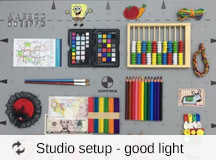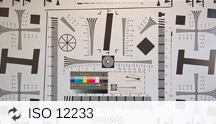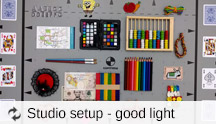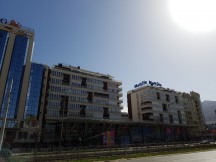Samsung Galaxy S7 review: A refinement act
A refinement act

New 12MP camera with dual-pixel tech for quick PDAF
More is usually better, and that's been Samsung's way of doing things for years, but with the Galaxy S7 that concept has been applied in different manner than you might think. The S6 had a 16MP camera, while the S7 has the total resolution lowered to 12MP. And that's about the only aspect where you could call the S7's camera a step back, though surely we've managed to convince you by now that pixel count is overrated.

The Galaxy S7 has larger pixels (1.4 micron vs. 1.12 micron), brighter aperture (f/1.7 vs. f/1.9), more phase detection subpixels (well, all 12 million something of them), all the while keeping the optical image stabilization of the predecessor.
It's the phase detection agent at every pixel that qualifies the S7's camera for a dual-pixel moniker, and you've certainly grown accustomed to hearing that every time imaging on the S7 is concerned. And Samsung is rightfully proud of it - competing smartphone phase detection systems only use about 5% of the total pixels for focusing, and dual-pixel PDAF is only a thing in the DSLR world.
It's worth noting that our review unit is equipped with the Sony IMX260 sensor, and not Samsung's own ISOCELL variant, though performance should be comparable with both.
The field of view is not as wide as on the S6 on the horizontal but the S7 captures more when it comes to the height of the scene.
The camera app is almost entirely the same as the one on the phone being replaced. It has a combined interface for stills and video, with virtual shutter release and record button on the one side and quick settings on the other. A few minor touches include an extra setting for resolution and a universally recognizable red dot symbol on the video record button instead of the more ambiguous video camera on older models.
Motion photo is available, too - it captures a three-second video before you've pressed the shutter and embeds it within the .jpg file. Upon the release of the phone, you could only view the videos on the device itself, or on other S7/S7 edge units.
Today, a few updates later, you can share the still image or the video separately with virtually anyone. Depending on the chosen aspect of the photo, you'd get either 960x720px or 1280x720px videos in an .mp4 format.
Pro mode gives you more photographic control and offers manual adjustments over shutter speed, exposure compensation, ISO sensitivity, and white balance. Manual focus is also available, and the S7 magnifies the center portion of the viewfinder, allowing you to better judge whats in focus and what not.
Image quality on the Galaxy S7 is excellent and the camera resolves plenty of detail. Noise, while present, contributes to adding texture instead of getting in the way. The level of resolved detail is mostly equivalent to the higher res images of the S6.
Color rendition is very much similar to the S6. Colors are vibrant, but not over the top, consumer-friendly describes them well. White balance is consistently accurate. Dynamic range is good, and in high-contrast scenes the S7 tends to expose to preserve the highlights, thus rendering some of the shadows black - arguably the better approach.
And here are a few shots taken with the Galaxy S6 for comparison.



Camera samples from the Galaxy S6
HDR mode is available on the S7 and it lets you toggle between Off, Auto and On. Samsung has struck a proper balance between salvaging details in both highlights and shadows, while also producing natural-looking images.
A set of night-time samples show the S7's performance in the dark. While you shouldn't expect miracles, the smartphone does a great job with night scenes, light sources are sharp and well defined, and a lot of the detail has been preserved. The output is a lot better than the S6 - comparison samples below shot at the same time.
The third sample was shot in a dimly-lit restaurant and could be taken as an indication of what to expect of the S7's camera in such social settings (not that lack of patrons looks awfully social).



Camera samples at night • Dimly-lit indoor scene


Camera samples at night from the Galaxy S6
The Galaxy S7 excels at panoramas too. When holding the phone in portrait the images can be as tall at the 4,032 pixels vertical resolution minus whatever cropping it needs to do to compensate for your tilting and moving the camera vertically. The Image below, for instance, measures 9,696x3,920 pixels or a total of 38MP, and it's not even a 180-degree rotation.
Aside from that, the stitching is flawless, with stationary objects, naturally. Exposure is consistent and the overall level of detail is nearly on par with still images. Now, Motion panorama is the new feature here and it records the action as it unfolds while you're sweeping, but that's not something we can show you here. The still panorama we can, find it below.
You can take a look at how the Galaxy S7 stacks up against the competition in our Photo Compare Tool.



Samsung Galaxy S7 in our photo compare tool
5MP front camera shoots good selfies
On the front the Galaxy S7 has the same 5MP camera as the S6, at least in terms of resolution. Apparently the target audience for the flagship doesn't take many selfies, Samsung thinks, and doesn't bother to install a higher-res sensor. Still, the aperture has gotten a bump to match the main shooter's f/1.7, and a screen fill flash is now available, too.
Videos are limited to 1440p, which is the most that can fit on the sensor in 16:9 ratio, and is also the resolution of the display.
Image quality from the front camera is more or less the same as the predecessor. It can't handle high-contrast scenes terribly well and blows out the highlights, but in all fairness, that scene would challenge a primary camera as well. More balanced lighting produces better results, and in any case skin tones are rendered in a very pleasing true-to-life way.



Selfie samples: Galaxy S7 • Galaxy S6 • Galaxy S7
The Galaxy S7 introduces a screen flash feature, which lights up the display to illuminate the subject (presumably yourself), helpful in the darkest of settings. It's not a new feature as smartphones go, it's just new to the Galaxy lineup. Below is a sample shot in our studio in complete darkness - quality is not overly inspiring but it's better than nothing which is what you'd get without the screen flash.
Video camera has it all
Befitting its flagship nature, the Galaxy S7's can capture video in 4K (2160p/30fps), 1080p/60fps, 1080p/30fps, as well as the less common 1440p/30fps and lesser resolutions. From the shooting modes you can select slow motion video (720p/240fps), and Hyperlapse. The latter has fixed speeds ranging from 4x to 32x, plus an Auto mode, where the S7 analyzes the footage and uses a variable speed depending on the action or lack thereof.
4K videos are recorded with a bitrate of 48Mbps, 1080p/60fps are 28Mbps, while regular speed 1080p/30fps get 17Mbps. Either way audio is recorded in stereo at 256Kbps, so no complaints on the numbers.
None when it comes to video quality either. 2160p videos are packed with detail, you can extract frames and have them pass as an 8MP photo, almost. Color reproduction is the same as still images, saturation neither drops, nor is additionally pumped up.
1080p/60fps is the one area we experienced some issues with focus hunting, apparently the S7 thinks that since we're using the higher framerate, we must be following some action closely. Other than that, videos are smooth and detailed, perhaps with a little noise in the darker areas. At 30fps the focusing is calmer and doesn't give us any reasons to protest.
You can also download the untouched video samples: 4K at 30fps (15s, 84MB), 1080p at 60fps (15s, 49MB), 1080p at 30fps (13s, 26MB).
Finally, you can use our Video Compare Tool to see how the Galaxy S7 stacks against the competition when it comes to video capturing.



Samsung Galaxy S7 in our video compare tool: 2160p resolution



Samsung Galaxy S7 in our video compare tool: 1080p resolution
Reader comments
- Raj0984
- 21 Mar 2025
- rK8
Samsung need to launch S7 back with FE range hardware, many people like me needs a small phone with decent specs. And with charger also.
- Aronne Ronnie Farrug
- 13 Dec 2023
- gx8
Is the Samsung galaxy S7 compatible with my hearing aids Does it helps me when I receive a mobile call Because usually I cannot hear a thing with other mobiles. I await for your reply Thanks
- Anonymous
- 11 Jun 2023
- 8mp
I'm using a Samsung galaxy s5 mini and this sounds like a good and cheap upgrade

















